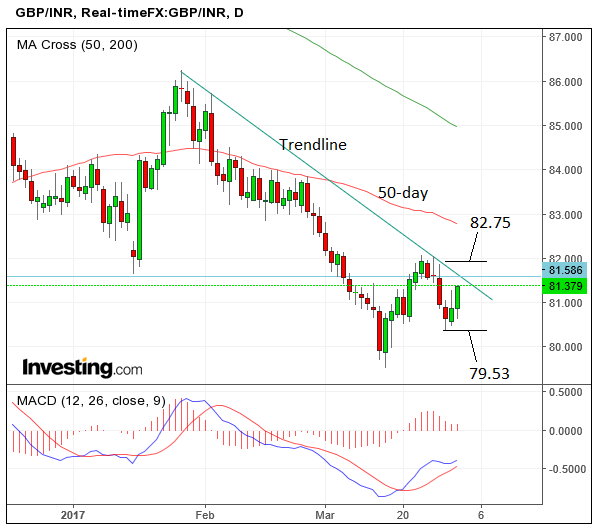Rupee Extends Uptrend ahead of Reserve Bank of India Meeting

The Indian Rupee extended its uptrend versus the Dollar at the end of last week reaching new yearly highs of 64.76 on Friday.
The Rupee fell back agains the Pound, however, with GBP/INR trading past its highs at 81.24 as Brexit risks declined materially, supporting Sterling.
The Rupee had been on a winning streak since the government solidified its mandate to conduct deep reforms of the economy by winning a landslide victory in the key state of Uttar Pradesh.
The victory has already increased foreign interest in India’s financial markets, with inflows peaking at US$6.91b in debt and equities in March alone.
“The BJP government's solid victory in the UP state elections has raised expectations for faster reforms, pushing through record highs in the NIFTY. Bond market inflows have also picked up with global financial conditions staying easy. At the same time, INR breaking below 66.30 has led to a shift in expectations around the RBI policy on INR,” said Morgan Stanley’s Hans Redeker in a note seen by Pound Sterling Live.
INR has also benefited from a general upturn in global risk appetite and an improvement in the outlook for emerging markets more generally.
Previously investors had concerns that the rising Dollar and fast pace of interest rate rises expected from the Federal Reserve, would put pressure on emerging market economies which hold a lot of Dollar-denominated debt, US-originated debt and must pay for their commodities in US Dollars.
These concerns, however, have softened due to scepticism about the Trump reflation rally extending, after his failure to push through reform of Obamacare failed, raising scepticism about his ability to get through even more radical infrastructure spending and tax reforms.
This has led to the view that Dollar appreciation and interest rate hikes will be much more gradual than expected, thus removing the pressure from EM’s.
It explains the record inflows from western investors purchasing EM assets recently.
“The globe has gone into reverse. Not so long ago the EM world caused worries while most of DM looked better, but now the opposite seems to be the case. EM inflows have reached record highs and may have further to go given that international investors have not reached 2012 levels of exposure, achieved when commodity prices where high and China was experiencing a 12% real economic growth rate. Strong EM inflows seem justified due to faster EM growth, and a widening differential to DM growth,” said Morgan Stanley’s Hans Redeker.
Pre-Monsoon Boon
Analysts also point to seasonal factors supporting the Rupee between February and Mid-April, linked to the timing of the monsoon, however, there are now concerns the currency may be topping due to the closeness of Mid-April.
“We advise forex investors to watch for a reversal in trade/rupee seasonality in April. We would like to point out that support of seasonality typically strengthens the rupee from February through mid-April. Summer and rains typically slow down industrial production and exports and weaken the rupee during April-September. As the weather improves in October-March, higher production and exports appreciate the rupee,” said BofAML in a note.
Indian Reserve Bank Rate Decision on 6th April
This week on Thursday the Indian Reserve Bank will meet to decide interest rates and monetary policy.
Rates are not expected to be changed from their current 6.25% level as the INB are keen to keep inflation down; the euphoria in the stock markets following Modi’s success in Uttar Pradesh also means a rate cut is highly unlikely.
Standard Chartered’s Nagaraj Kulkarni expects the Bank to shift its policy stance from accommodative to neutral, signalling a slight tightening of policy.
To offset any further strengthening of the currency the focus will shift to “liquidity management”, “via a “mix of conventional and new sterilisation tools.”
By “sterilisation” he means that the Bank will likely get involved in direct foreign exchange market intervention, probably to stem the rises in the Rupee from extending and impacting negatively on Indian exporters.
He further expects a new standing deposit facility to be announced, which will “bull steepen the Indian Government Bond curve and Overnight Index Swap curve”, thus probably shoring up support for India’s banks and other financial institutions.
Technical Studies Suggest GBP/INR Not Likely to rise above 81.34 on Monday
After two up days, today (Monday) will probably (66%) end lower than 81.34 where it opened, given the downtrend favours a resumption lower, and research shows the market has a tendency to resuming the dominant trend after two counter-trend days.
The pair has also been correcting in the midst of a strong down-trend on the weekly chart too.
Only a break above the key trendline signalled by a move above 82.00 would alter the bearish bias.
Such a move would be a stronger signal of reversal and would indicate a probable follow-through to 82.70 just below the 50-day moving average.
Momentum is stronger than normally expected for a correction, supporting the possibility of a breakout higher.
A failure to break above the trendline could indicate the more dominant down-trend is resuming and see a move back down to the historic 79.53 lows, and then probably even lower.
Such a move would be confirmed by a break below the 80.39 lows established on March 29.







